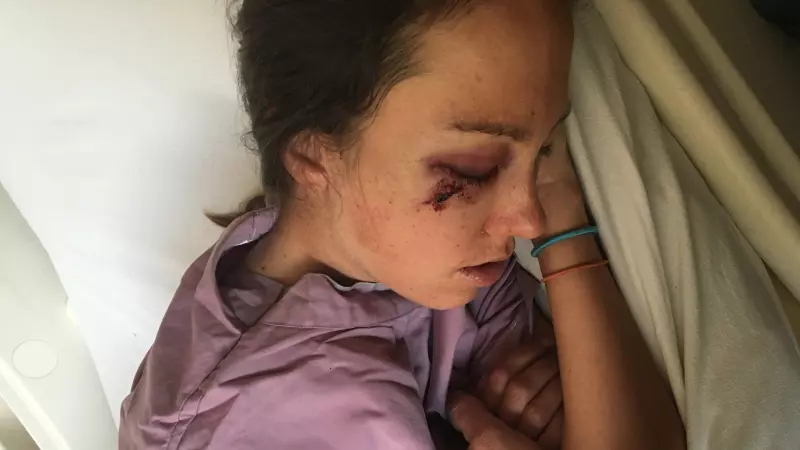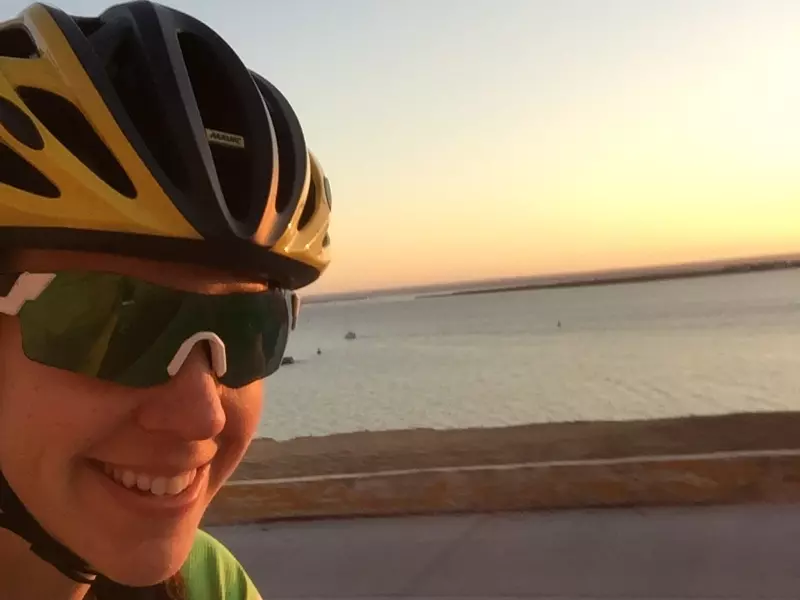

“I’ve been a road cyclist for 10 years. As bike racers, it always crosses our mind that crashes can happen, but usually it is road rash or bruising, or worst case scenario maybe you break an arm or a collarbone. Rarely does anybody think of brain injury.”
Kathryn Bertine is a former professional cyclist. She found herself seizing on the ground with a broken skull after a crash during a 2016 race in Mexico. She doesn’t remember the days that followed in the ICU and her year-long recovery was spent in different hospitals and learning how to live her old life after a brain injury. In this story, read about Bertine’s recovery journey and why she pledged to donate her brain to the Concussion Legacy Foundation.

Posted: April 3, 2017
Former professional cyclist Kathryn Bertine speaks cogently and confidently as she discusses her decision to pledge her brain to the Concussion Legacy Foundation. “When my time is up, I certainly don’t need my brain, but if somebody else can benefit from understanding it, then that makes me so happy.” Kathryn’s voice has an unmistakable liveliness and optimism to it, as though she’s sitting across from a young cyclist that might someday benefit from the research she is supporting with her pledge.
That liveliness and optimism might be the byproduct of surviving the crash that left her lying on a road in Mexico, her skull broken in two places, seizures overtaking her body, her family hundreds of miles away. That crash was one year ago today.


When the wreckage began to clear, some of the affected racers gingerly got back on their bicycles and finished that last mile. Others cleared to the side of the road to tend to more serious injuries. Kathryn was sent into seizures. She had broken her clavicle, suffered two skull fractures (right temporal and sphenoid bones), and endured a severe concussion from the coup-contrecoup brain injury, as she would later be told. Kathryn could only lay helpless while the chaos of the scene spun around her.


The next 72 hours were touch and go. Doctors at the Mexican hospital where Kathryn was delivered were monitoring the massive swelling in her brain to determine whether or not she would need surgery. Her seizures became more minor until they finally dissipated enough for the doctors to decide they wouldn’t need to drill into her skull. Kathryn spent five days in the ICU of that Mexican hospital before she was airlifted back to the trauma unit of the University Medical Center in Tucson, Arizona. Her memory of these days consist only of a snippet here and a snippet there. Green Jell-O that she was fed by the nurses. A soft, brightly-colored fleece blanket. A companion who had flown in to be by her side. But mostly, that tense time when Kathryn’s family waited to hear whether she would regain normal brain functioning was, to Kathryn, just a fog.
“Whether through social media, real friends who I see on a daily basis, or strangers, everybody was truly kind and supportive of me. That moved me. That genuinely moved me, to see that people cared that much.”

Kathryn looks through some of the many well-wishing cards she received during her recovery.
Kathryn’s next stop after the near-two weeks in the trauma unit was yet another hospital in Tucson—St. Joseph’s—where she was monitored and evaluated for brain function. After a week there, she spent a month in bedrest at her father’s home to regain the strength to transition back to living her life. She had to overcome her own stubbornness at times; understanding the challenges that lay ahead was the most important part of setting her recovery on the right path.
“I remember sleeping a lot. I took that very seriously during recovery – that rest was best. That was hard for me to juggle as a professional athlete; being there laid out on the couch was something that I clearly struggled with. I was thinking, is it going to be this way forever? Am I going to be able to return to the life I loved as an athlete? Am I going to be able to use my brain again to full functionality? I just had to be patient during that part of the journey.”
Kathryn’s network of caregivers provided comfort and inspiration. “I felt surrounded by people who were supportive. My dad, my friends, my business partner, my former boyfriend, even cycling fans and complete strangers… everyone was so incredible, kind and helpful. Finding a support network of close loved ones where I could be honest about how I was feeling helped me progress tremendously, because I could be my authentic self. That’s something I would suggest to anyone who is going through any type of brain injury, to have those people, whether family or friends or doctors, who work with them to get over those emotional and physical hurdles. That did such an amazing thing for me, to be able to have people to talk to.

In July, Kathryn joined her team in Bend, Oregon to race for the first time after her accident.
The need for patience continually revealed itself, reminding Kathryn to listen to her body and be deliberate with her recovery. There was no shortcut to this finish line. As time passed, her strength increased.
Kathryn’s year of recovery inevitably led her to reflect on the issue of brain trauma within her sport. She didn’t emerge with a fear of riding or a regret for the sport she chose. After being carefully monitored by her doctors and neurosurgeons, she even got back on the bike late last summer for one final event in pro cycling. “I wanted to race once more,” she says, “but not to win. I won when I woke up in the hospital. This time, I raced for personal closure.” She wanted to mark the end her professional career with something other than a traumatic brain injury, and she did so successfully, finishing the race safe and sound.
But Kathryn did emerge with a more crystalized perspective on safety in sports. People who learn about the severity of her accident always ask whether she was wearing a helmet, Kathryn says. “Of course I was! But even if you’re wearing a helmet, really bad things can happen. We don’t address that enough in any sport.”
“When my time is up, I certainly don’t need my brain. But if somebody else can benefit from understanding it, that makes me so happy.”

After retiring from professional cycling in 2017, Kathryn Bertine now works as CEO of the Homestretch Foundation, which combats salary inequity for women in professional sports.
The VA-BU-CLF Brain Bank has now accepted more than 400 brain donations, and has received over 1,500 pledges. Most of those donations and pledges have come from men. By pledging her brain, Kathryn becomes the first official pledge from professional cycling and joins a growing list of prominent female athletes to pledge and raise awareness of the importance of concussion and CTE research. The list includes soccer legend Brandi Chastain, Olympic gold medalist Nancy Hogshead-Makar, and most recently Olympic hockey icon AJ Griswold, a friend of Kathryn whose story inspired her to pledge. These high profile pledges are making a difference; female brain pledges in 2017 are on track to triple the amount received in 2016.
“This pledge gives me emotional closure. If I am lucky enough to live through this traumatic brain injury, it makes me so happy to pledge my brain to research so that others can learn from what happened to me. I hope my story can help encourage other cyclists and athletes to pledge too.”
Exactly one year after her horrific crash, Kathryn Bertine is in high spirits with an eye toward the future. She tells her story as a way to rally the cycling community to contribute to brain trauma research. She is planning a trip to La Paz, Mexico in May to thank the doctor who saved her life. When asked her impressions of the doctor, Kathryn says: “He’s incredibly humble. I had tears in my eyes as I wrote a note thanking him for saving me in the middle of the road, and he humbly replied, ‘I was just doing what needed to be done.’” Altruism, it seems, is contagious.